
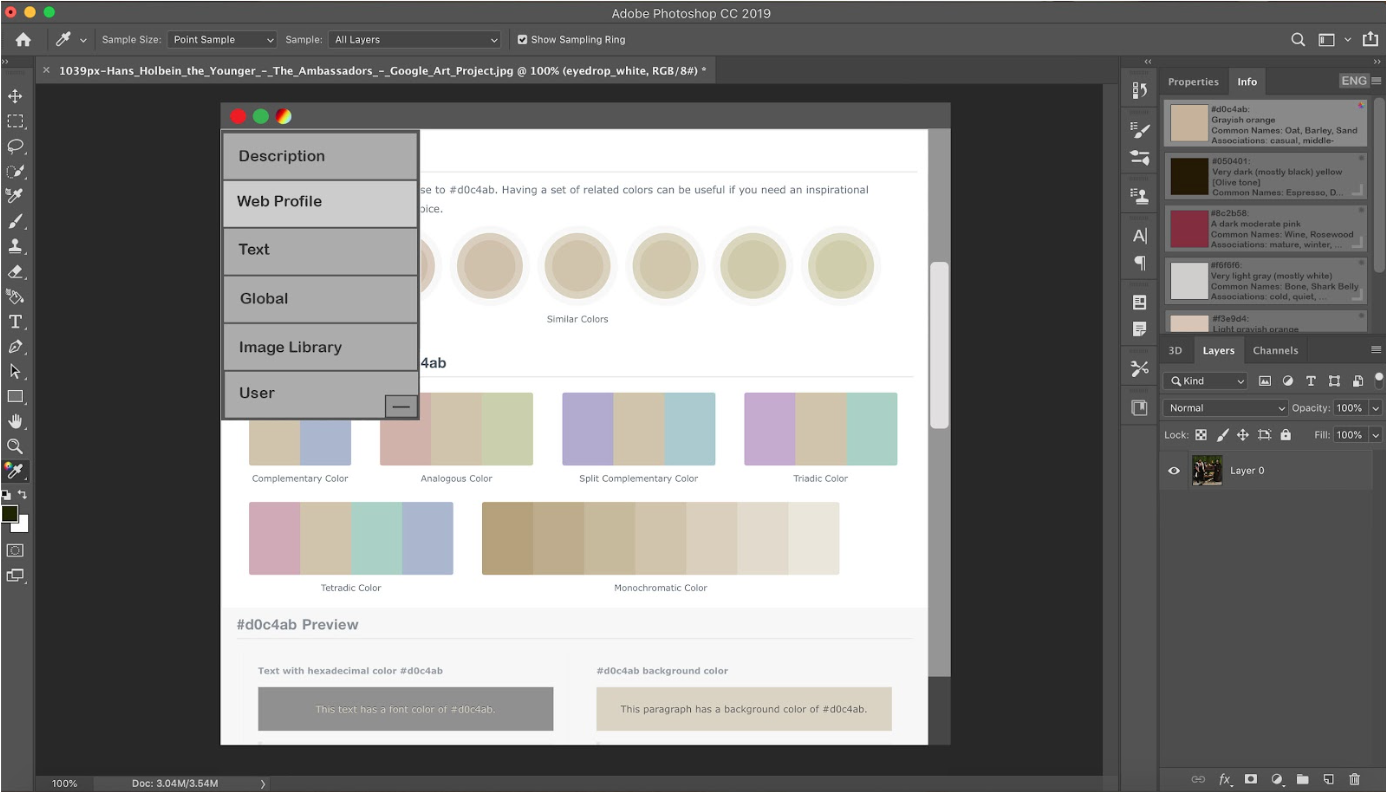

Adobe Mnemosyne
Color is an essential tool in life and art for the interpretation of everything from emotion to subliminal reaction to the literal reproduction of the natural world. Every shade and hue on the spectrum of color can invoke a different response. Each color variant has a different history of use and reference. Every shade has a life beyond the color scale, and creative professionals should want to become familiar with all their tools. Photoshop users range from students to graphic designers, digital artists, photographers, and other graphic professionals. In every step of a user’s career, the colors used in their work affects the audience’s perception of a product and or art. If color holds such a great grasp on interpretation, why isnt color history a part of this tool?
Every color has a narrative. The new narrative of the database is heavily debated now on its readability but I think it can be compared to reading color. A color lives as one, like a single cell, and is surrounded by hundreds of other cell/pixels to build a bigger picture. A cell or pixel is informed by its surroundings. A cell can live on its own, and can have a full book worth of narrative in its single cell/pixel. The cells/pixels around it just tell a different story.
Mnemosyne, as well as a majority of Adobe’s apps are learned through play. Learning through play expands through many mediums of education and studies. In Michelle A. Honeyford and Karen Boyd’s, Portraits, Photoshop, and Visual Literacy Practices they quote American researcher, J.P. Gee who states:
“A science such as biology is not a set of facts. In reality, it is a "game" that certain types of people"play." These people engage in characteristic sorts of activities, use characteristic tools and language, and hold certain values; that is, they play by a certain set of "rules." They do biology.”
Photoshop is like biology, you do Photoshop. Photoshop and the Adobe CC platform are designed for doing. You can only learn Photoshop through experimenting and playing with its many functions and tools. The addition of the Color History Tool provides users a new way of playing with our app through color and history.
The Color History Tool for Photoshop will be added as an extension to the eyedropper palette of available options. The eyedropper is the most logical place to insert the Color History Tool because it already is used to select color pixels. The eyedropper palette is one of the features of Photoshop Adobe has been enhancing in the past few updates with the Color Sampler Tool and the 3D Material Eyedropper Tool. The Color Sampler Tool is essentially the preface to the potential of the Color History Tool. The Color Sampler Tool pinpoints a single pixel and provides users with a brief web color profile; it provides the chosen pixels “RGB Color,” “CMYK Color,” “Web Color,” HSB Color,``''Lab Color,” and “Grayscale.” The Color History Tool, which I am proposing to add to Photoshop will broaden the users scope of vision on what the chosen pixel color’s significance is in the greater scheme of its attributes and it’s impact on realm it influences, whether digital, analog, natural, man made, or fabricated.
The Color History Tool is an educational tool first, and helps keep research and work in one place so users don’t have to have a cluttered screen and desktop. In building a bibliography of color, users are encouraged to play, and discover new things through bouncing around the pixels of their images, or scrolling through the hue cube or color wheel. If users find a color they like, or a profile they find interesting, they can bookmark the color and it will be synced and saved automatically to the Mnemosyne application as well as in the bookmarks saved to the Color History Tool in Photoshop.
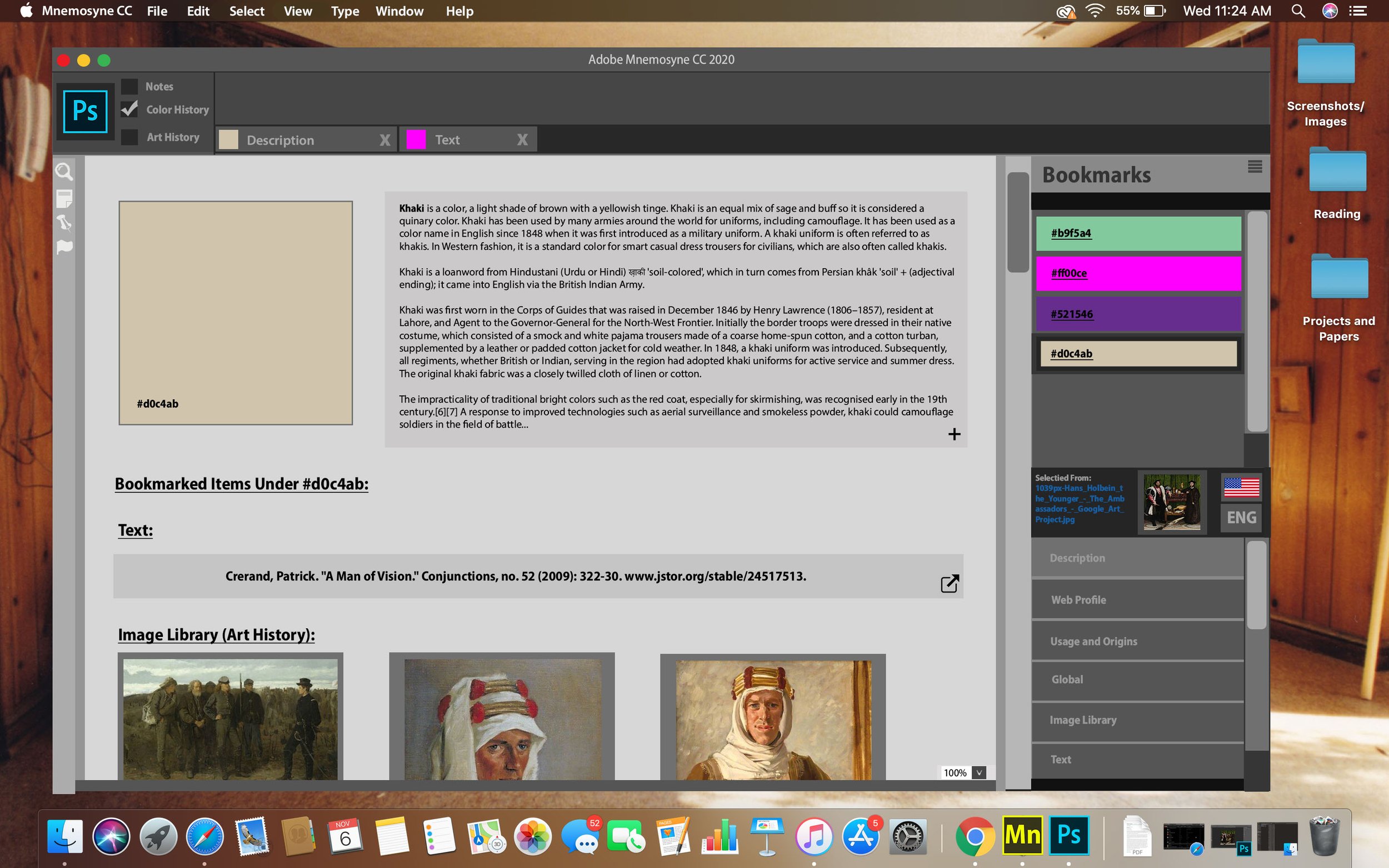
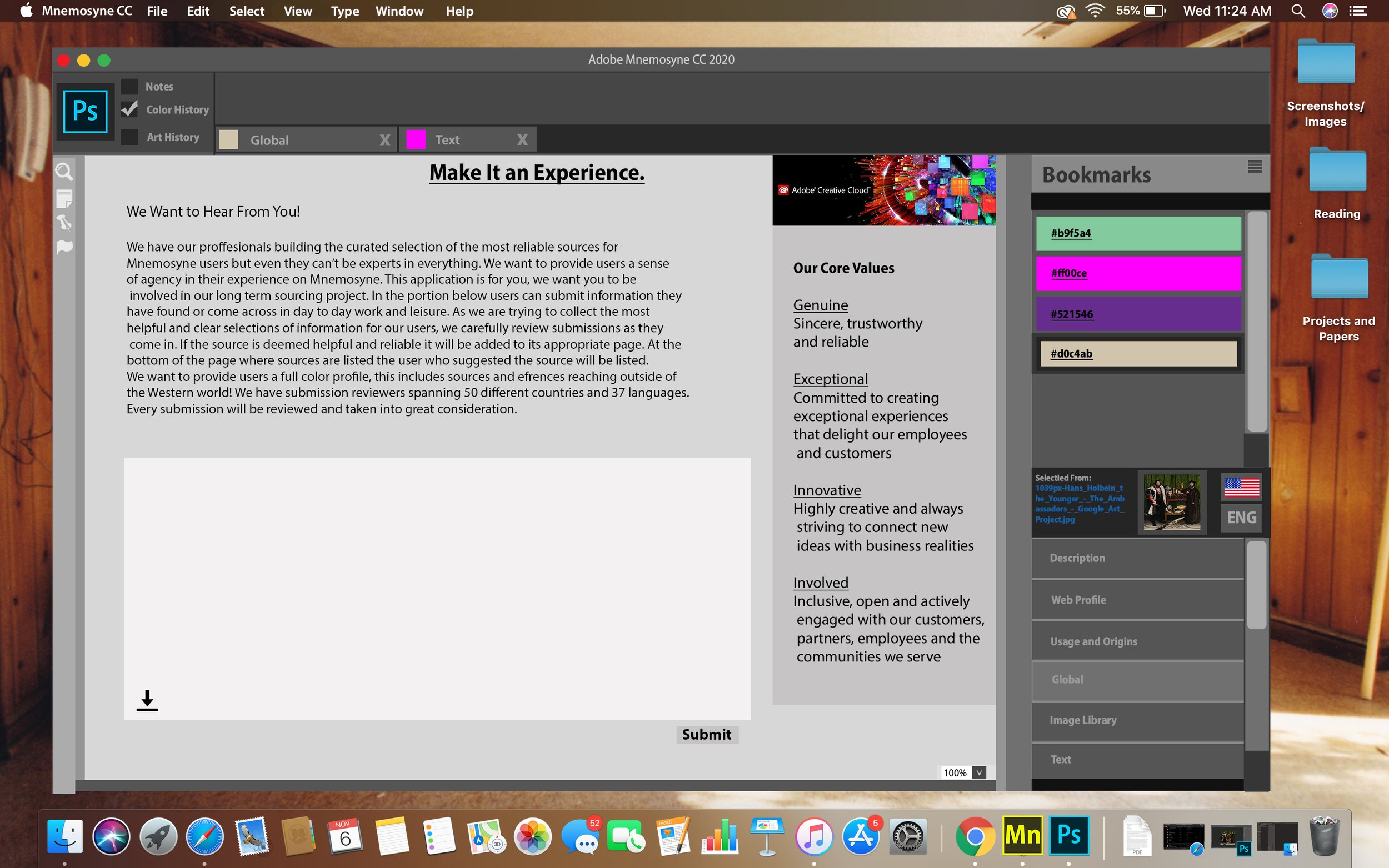
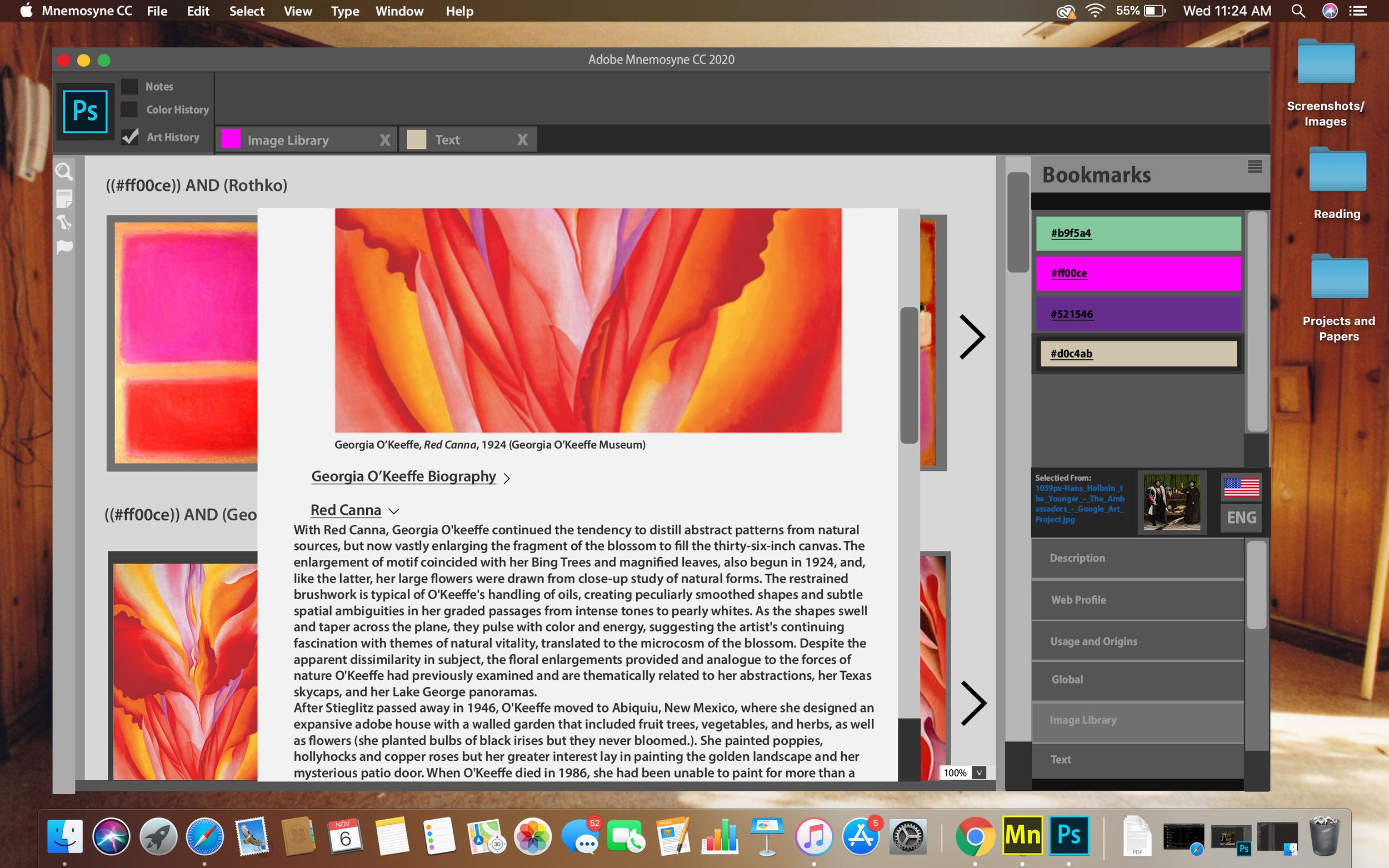



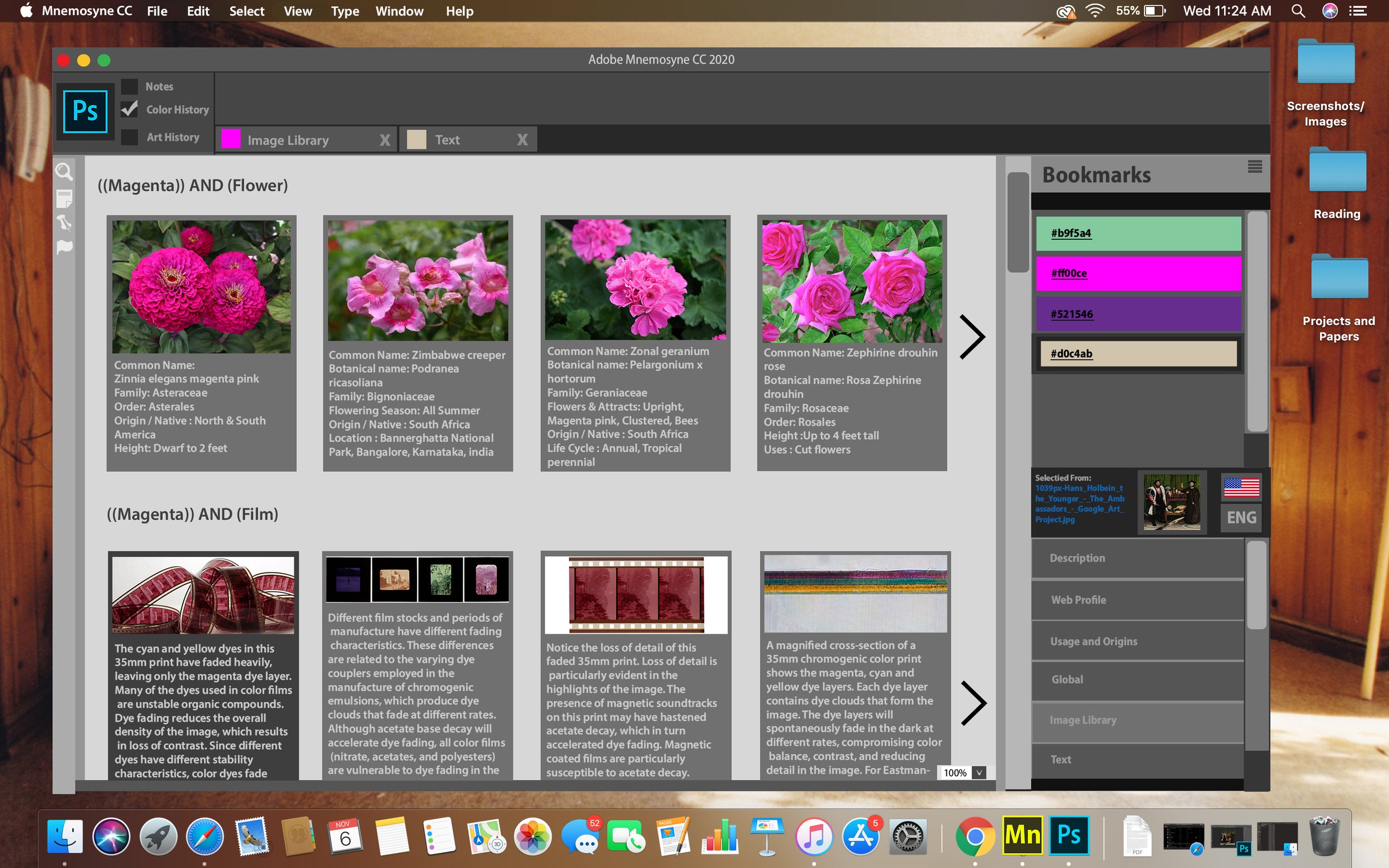
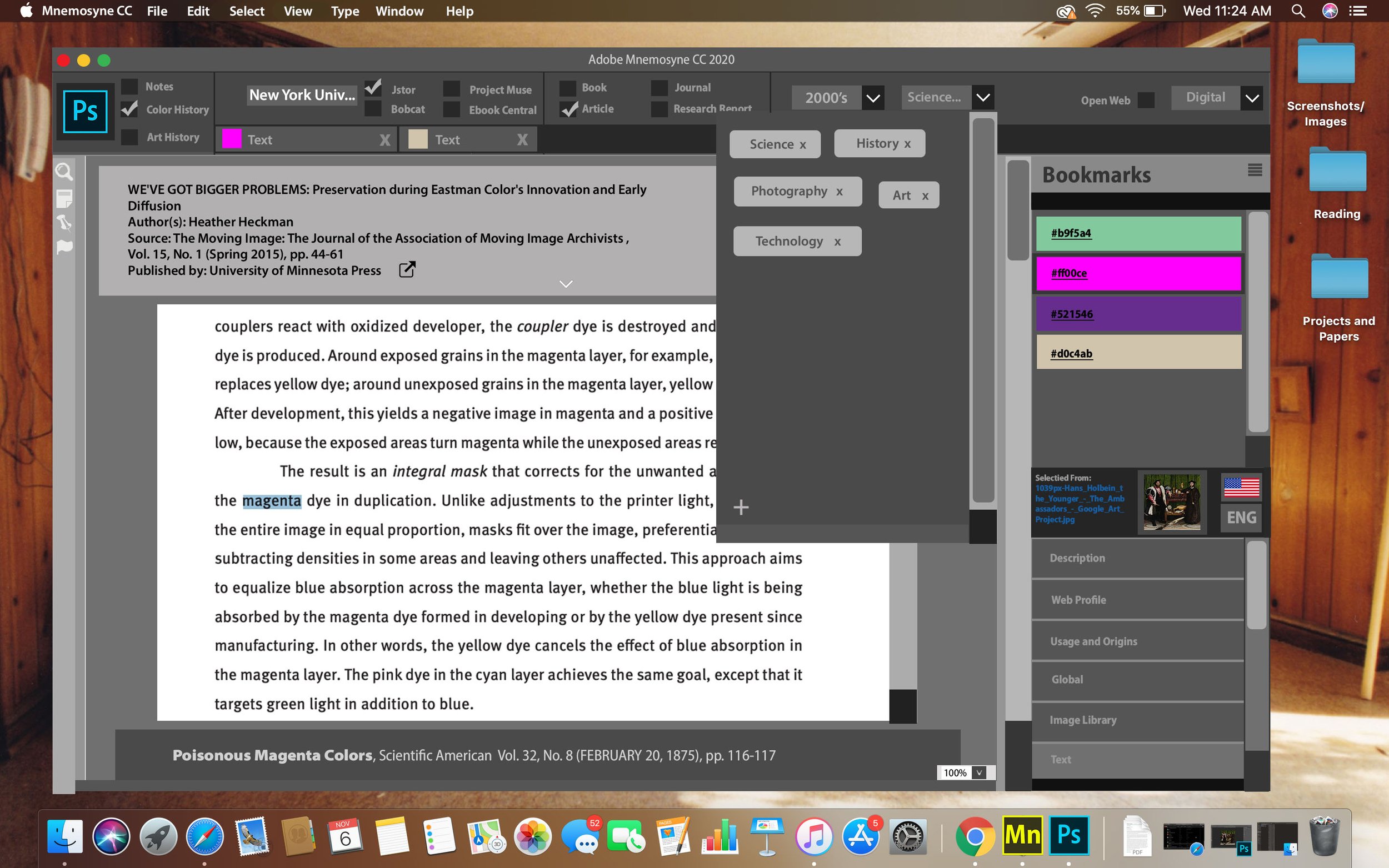
Mnemosyne has three modes of curated information. Then there is the “Color History” mode, which is the default mode. In the “Color History” mode users will be provided hundreds of thousands of sources and references pertaining to a single color, with no particular focus on one subject. The subject can be narrowed through by the user through the tagging and or searching function. “Color History” will be looking at references to the color from nature to artificial man-made goods. This mode will source on an international scope and reach out to the different points of the earth to seek unique and not commonly known facts and information about each color. Through “Color History” mode a user will be able to get a worldly viewfinder for each color.
Next, there is the “Art History” mode where users can select all the sources to be specifically pertaining to art. This function will be particularly helpful in the Image Library so a user can more easily navigate a color’s significance in art through specific artists, mediums, movements, and periods. “Art History” mode helps give reference to how color has been perceived by man throughout visual culture and history. Color is the basis of art, as well as form and scale. Without color, art lacks context and without art, color lacks depth.
Finally, there are Notes, which are curated by the user, either through writing their own reflections here in their notepad or through their saved lines from the provided texts in other tabs. What the user contributes to their “Notes” mode on Mnemosyne is private to them, but through the “Global” tab of either the “Art History” or “Color History” mode users can submit information and sources they feel would add nicely or fill a gap they find in a profile. Each submission will be carefully reviewed and if a user-submitted source is accepted and added, the user will be notified. The submissions that will be accepted are either from in-app text entry, PDF, Docx and for images, PDF, JPEG, PNG, TIF, and in network file type.
In the Mnemosyne, application users will be able to work with their specific color profiles and be able to highlight and save textual information provided regarding the colors in the “Notes” portion of the app. If a user desires to save a source, rather than textual portions, and/or any other source form Mnemosyne-like images, then they will be saved and appear in the “Description” tab. In the “Description” tab, there will also be a brief description of the history of the color. The “Description” Tab is the default home page when a user selects a color. They can then choose new tabs and or switch modes from this page.
The “Image Library” is where a user can find a selection of images, with accompanying descriptions, that are separated into commonly associated tag categories with the color and its common use names. For example, for the color #ff00ce, it is most commonly referred to Magenta, so one tag word it would maybe be associated with in Color History mode is ‘flower.’ Magenta in nature can most commonly be referred to in flowers. Under the tag “((Magenta)) AND (Flower) a selection of flowers containing this color will show-up with their full flower background. In the Art History mode, under #ff00ce, the color will be tagged to something of someone directly involved in the arts. For example, #ff00ce might be tagged to Mark Rothko because in a selection of his color block paintings he uses this shade or a shade similar to it. When the user selects a particular painting they will be given a description of the painting as well as the artist and the art career and relevance.
Besides the “Image Library,” the “Text” tab will be the major source for research and information pulling. “Text” will work as a mass catalog of sources pertaining to the color. Due to the right and restrictions of digital texts, the publicly available sources will be the base of sources provided to users. If the user is using an account sponsored or linked to an educational institution or corporation, the institution or corporation can add their affiliated source banks and libraries, like Jstor and Ebook. If a user holds an account to these sites then they can individually link their accounts to Mnemosyne. As Adobe grows, I hope that Mnemosyne will gain partnerships and/or ownership over these types of sourcing sites. Until then, a user must obtain or already be affiliated with these sites to get a more full and elaborate experience in the “Text” tab.
In tabs like the “Web Profile” and “Usage and Origins,” the information provided is written and collected by our color experts and research teams and have no limits of access. The “Web Profile” will display a colors complete web color profile including a much more expanded color background then the current Color Sampler Tool in Photoshop. This will include such aspects as saturation scales, compatible color scales, text to background comparisons, alternatives, shades, tints, tones, and many more aspects of digital display of the color and its range. As Photoshop and Adobe Creative Cloud are tools aimed towards digital creatives, it is important to provide a thorough description and features of how the color live and appear on the screen.
“Usage and Origins” will break down the relevance of the color in history and its associations. This is where the commonly referred to terms and names can be found. “Usage and Origins” is an extended view and sourcing of the brief introduction to the color history on the “Description” page. “Usage and Origins” will act as go-to source for everything relevant to the life of the color in culture and its appearance.
To keep Mnemosyne sleek and an open canvas for learning and play, it has been decided to make this application reliant on shortcuts. I wanted this application to feel and look less intimidating to new Adobe users. Mnemosyne will carry over many of the well known shortcuts for web use, such as Command F (Control F for PC) for search and Command C and V (Control C and V for PC) for copying and pasting text in “Notes.” This will help make Mnemosyne feel like a more recognizable and comfortable source to research. The user experience is formative in how I thought about the layout and structure. So I also put small icons for some of the essential commands like search and highlight on the sidebar of the window. This gives the users several pathways to finding the sources and information most important to them and their research.
I decided to make this application and tool through Adobe instead of creating an outside network or plug-in, because it will already have a built in user base with prior Adobe subscribers and because Adobe has more starting resources and money then an outside network would have for this type of project. With the amount of man hours needed to get this project started, it would take a longer amount of time to get this tool on the market and available to potential users. Since there are so many legal considerations regarding such issues as copyright, reproduction, and distribution, especially in the “Text” portion, I believe there is no foreseeable way to provide all the resources of the app and tool for free. While Adobe Creative Cloud applications are not free, the suite of applications is the industry standard, with a huge number of registered users, many coming from institutions that pay a portion or fully for these accounts. Mnemosyne and the Color History Tool, will be an added bonus to the Adobe CC suite membership. I want to provide registered users more ‘bang for the buck’ to Creative Cloud than is currently given to them. While I think outside networks and plug-ins are valuable, I think for this project it would not be financially feasible. I think providing it to an already established and evolving platform such as Photoshop and the Adobe Creative Cloud platform, where it can be provided to users automatically with an update will help promote the tool and app for a speedier acceptance into research and the work of users.


